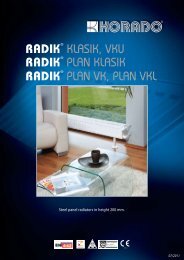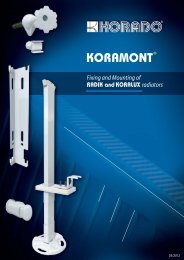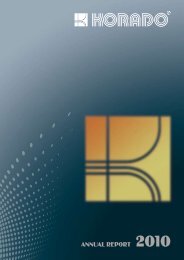RADIK are steel panel radiators - KORADO, as
RADIK are steel panel radiators - KORADO, as
RADIK are steel panel radiators - KORADO, as
Create successful ePaper yourself
Turn your PDF publications into a flip-book with our unique Google optimized e-Paper software.
SVÚOM PRAHA – INFORMATION<br />
SVÚOM PRAHA – INFORMATION<br />
(I.E. STATE RESEARCH INSTITUTE FOR PROTECTION OF MATERIALS)<br />
The below given information defines conditions for appropriate<br />
using <strong>steel</strong> <strong>radiators</strong> which <strong>are</strong> protected with final surface finish in<br />
accordance with DIN 55 900 standard. It also specifies critical locations,<br />
spaces and environment limiting their applications. <strong>KORADO</strong>,<br />
a.s. (joint-stock co.) recommends the below given advice to be strictly<br />
respected at all practical applications because this will be taken into<br />
consideration in c<strong>as</strong>e of judgement and evaluation of any future<br />
claims and/or complaints.<br />
POSSIBILITIES AND LIMITATIONS FOR<br />
USING STEEL RADIATORS WITH SURFACE<br />
FINISH ACCORDING TO<br />
DIN 55 900 STANDARD:<br />
(Explicit comment from the Prague State Research Institute<br />
for Protection of Materials)<br />
1. REQUIREMENTS FOR SURFACE FINISH<br />
OF RADIATORS<br />
1.1. General<br />
The requirements concerning the surface finish of <strong>radiators</strong><br />
<strong>are</strong> defined in German standard DIN 55 900 which bears<br />
the following title: “Surface finish of <strong>radiators</strong>. Terminology,<br />
requirements, tests. Surface finish made industrially.“<br />
The said standard relates to materials which <strong>are</strong> used for<br />
surface finish of <strong>radiators</strong> and it is binding for industrially<br />
made surface finish of <strong>radiators</strong> for hot water heating and<br />
low pressure steam heating (temperature of the heat-carrying<br />
medium up to 120 °C).<br />
The object of the said standard in not surface finish of <strong>radiators</strong><br />
operating with temperatures exceeding 120 °C or which <strong>are</strong> to be<br />
used in spaces with aggressive and/or humid environment air. Kitchens,<br />
bathrooms etc. and places outside the reach of water shower<br />
spraying and toilets <strong>are</strong> not considered to be spaces with aggressive<br />
and/or humid environment air.<br />
The DIN 55 900 standard is divided into 2 parts: DIN 55 900-1 defines<br />
the b<strong>as</strong>e paint layer for <strong>radiators</strong>, DIN 55 900-2 defines the final<br />
surface finish of <strong>radiators</strong>. The said standard specifies reguirements<br />
on paint coating materials applicable for surface finish, i.e. both their<br />
physical-mechanical properties (adhesion, impact<br />
resistance)and corrosion resistance (resistance against condensating<br />
water).<br />
In general terms, the said standard also requires that <strong>radiators</strong><br />
with final paint coating must be protected appropriately<br />
for and during: transportation, storage, and mounting, and it<br />
must be possible to clean the <strong>radiators</strong> surface with common<br />
detergents (non abbr<strong>as</strong>ive).<br />
The said standard is the b<strong>as</strong>is for definition and <strong>as</strong>sessment<br />
of the surface finish quality and for compliance with all<br />
principles therein stipulated, all of which is binding both for<br />
manufacturers and users of <strong>radiators</strong>. B reach of the scope<br />
of the standard DIN 55 900 by the user may be the cause of<br />
extinction of the producer´s quarantees.<br />
2. QUALITATIVE DESCRIPTION OF TYPICAL<br />
ENVIRONMENTS<br />
The qualitative description of typical environments with<br />
relevant grades of corrosivity is given in the table under the<br />
following title:<br />
Qualitative description of typical environments for judgement<br />
of corrosivity grades:<br />
94 The company reserves the right to make technical changes.<br />
Corrosivity<br />
grade<br />
C-1<br />
C-2<br />
C-3<br />
C-4<br />
C-5<br />
Corrosivity<br />
Very low<br />
Low<br />
Average<br />
High<br />
Very High<br />
Examples of typical<br />
interior environments<br />
Heated spaces with relative low humidity (30<br />
– 65 %) and with negligible uncleanliness, e.g.<br />
office premises, schools, museums, flats, hotels,<br />
shops, etc.<br />
Unsufficiently heated spaces with changeable<br />
temperature and with relative humidity exceeding<br />
70 %. R<strong>are</strong> occurrence of condensation<br />
and minor uncleanliness, e.g. w<strong>are</strong>houses,<br />
corridors, gym halls, etc.<br />
Spaces with average occurrence of condensation<br />
and with average uncleanliness caused by<br />
technological or other processes, e.g. food<br />
production premises, laundry plants, breweries,<br />
dairy houses, meat packing factories, etc.<br />
Spaces with high occurrence of condensation<br />
and with average uncleanliness caused by technological<br />
or other processes, e.g. industrial<br />
manufacturing premises, swimming pools, bath<br />
houses, car-w<strong>as</strong>hing facilities, public WCs,<br />
stables, etc..<br />
Spaces with nearly constant occurrence<br />
of condensation and/or with high uncleanliness<br />
caused by technological processes, e.g. mining<br />
premises, underground technological spaces/<br />
rooms/halls, unaired shelters in tropical humid<br />
<strong>are</strong><strong>as</strong>.<br />
The <strong>radiators</strong> with surface finish complying with the DIN 55<br />
900 standard <strong>are</strong> applicable in spaces/premises with C 1<br />
interior air environment without limitation for a long period<br />
of service.<br />
However, pursuant to the DIN 55 900-2 standard, the <strong>radiators</strong><br />
must not be placed in spaces with aggressive or humid<br />
environment air (C2 – C5). Any placement of such <strong>radiators</strong><br />
in the lower defined spaces must be considered <strong>as</strong> critical.<br />
3. POSSIBILITIES AND LIMITATIONS FOR USING<br />
STEEL RADIATORS WITH SURFACE FINISH<br />
COMPLYING WITH DIN 55 900 STANDARD:<br />
3.1. Spaces with possible water spray or water<br />
solutions spray<br />
In spaces/premises with the C 1 interior environment air, e.g.<br />
in flats, offices, schools and other public buildings, there <strong>are</strong> also<br />
some rooms (kitchens, bathrooms, toilets) wherein some places with<br />
corrosion activity of C 2 – C 5 can be found.<br />
These <strong>are</strong> places within a direct reach of water spray or water<br />
solutions spray (e.g. places under kitchen sinks, under w<strong>as</strong>h-b<strong>as</strong>ins,<br />
under showers, and some other places which <strong>are</strong> regularly sprayed<br />
with water). Such places <strong>are</strong> considered <strong>as</strong> spaces with humid or<br />
aggressive environment air and they <strong>are</strong> not suitable for placing <strong>radiators</strong><br />
there even though the whole rooms in question (i.e. kitchens,<br />
bathrooms, toilets) <strong>are</strong> not considered to have aggressive or humid<br />
environment air.





